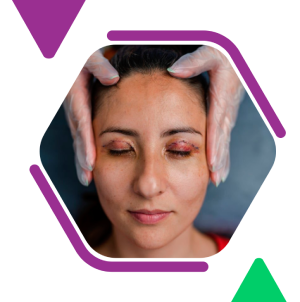- Home
- About Us
- Hair Treatment
- Hair Transplant
- Hair Loss
- Causes of Hair Loss
- Clinical Features
- Laboratory Test
- Medical Treatment
- Cyclic Treatment
- PRP
- Laser Treatment
- Surgical Treatment
- FUE
- Robotic
- FUT
- Beard Reconstruction
- Moustache Reconstruction
- Eyebrow Reconstruction
- Side Burn Reconstruction
- Complications Of Hair Transplant
- Alopecia Areata
- Telogen Effluvium
- Cosmetic Surgery
- Plastic Surgery
- Gallery
- Blogs
- Contact Us
Blepharoplasty

Blepharoplasty
Blepharoplasty (BLEF-uh-roe-plas-tee) is a type of surgery that repairs droopy eyelids and may involve removing excess skin, muscle, and fat. As you age, your eyelids stretch, and the muscles supporting them weaken.
Blepharoplasty (BLEF-uh-roe-plas-tee), commonly referred to as Eyelid surgery, is a surgical procedure that repairs droopy eyelids by removing excess skin, muscle, and fat. As people age, the eyelids tend to stretch, and the muscles supporting them weaken, leading to a sagging appearance. This can affect both the upper and lower eyelids, causing not only aesthetic concerns but also functional issues such as impaired vision.
Causes and Indications for Blepharoplasty
The primary cause for considering eyelid surgery is the natural aging process. Over time, the skin loses its elasticity, and the constant pull of gravity causes excessive skin to collect on the upper and lower eyelids. Factors such as genetics, sun exposure, and lifestyle choices like smoking can accelerate these changes.
Functional and Aesthetic Benefits
Improved Vision: One of the significant functional benefits of eyelid surgery is the improvement in vision. Excessive skin on the upper eyelid can droop over the eyelashes and obstruct peripheral vision, making daily activities such as reading and driving difficult. By removing this excess skin, eyelid surgery can restore a full field of vision.
Youthful Appearance: Aesthetic improvement is another major benefit. Droopy eyelids and puffy bags under the eyes can make a person look older and more tired than they feel. Eyelid surgery can rejuvenate the appearance, giving a more alert and youthful look.
Symmetry and Balance: Some individuals have asymmetry between their eyes, where one eyelid droops more than the other. Eyelid surgery can help achieve better symmetry and balance, enhancing overall facial harmony.
The Procedure
Blepharoplasty can be performed on the upper eyelids, lower eyelids, or both, depending on the patient’s needs and goals. The surgery is typically done on an outpatient basis under local anesthesia with sedation, or sometimes under general anesthesia.
Upper Eyelid Surgery: In upper eyelid surgery, the surgeon makes an incision within the natural crease of the eyelid, through which excess skin, muscle, and sometimes fat are removed. The incision is then closed with fine sutures, which minimizes visible scarring.
Lower Eyelid Surgery: Lower eyelid surgery involves an incision just below the lower lash line or inside the lower eyelid (transconjunctival approach). Through this incision, the surgeon can remove or reposition excess fat to eliminate puffiness and bags, and may also remove a small amount of skin to smooth the area.
Combined Procedure: For a comprehensive rejuvenation, many patients opt for both upper and lower eyelid surgery in a single session. This combined approach addresses all areas of concern and maximizes the aesthetic benefits.
Recovery and Results
Recovery from eyelid surgery varies from person to person but generally involves several key stages:
Immediate Post-Operative Period: In the first few days following surgery, patients can expect some swelling, bruising, and discomfort around the eyes. Cold compresses and prescribed medications can help manage these symptoms.
First Week: Most patients return to their normal activities within a week, although they may still have some bruising. Stitches are typically removed within five to seven days.
Long-Term Recovery: Swelling and bruising continue to subside over several weeks. The final results of eyelid surgery, including smoother, more youthful-looking eyelids, are usually visible within a few months.
Risks and Considerations
As with any surgical procedure, eyelid surgery carries some risks and potential complications. These can include infection, dry eyes, difficulty closing the eyes, scarring, and, in rare cases, vision changes. Choosing an experienced, board-certified plastic surgeon can help minimize these risks and ensure a safe procedure and satisfactory outcome.
Advanced Techniques and Trends
Modern blepharoplasty techniques have evolved to provide even better results with less downtime. Some advanced approaches include:
Laser Eyelid Surgery: This technique uses laser technology to make precise incisions and remove tissue. The laser can reduce bleeding and bruising, leading to a quicker recovery.
Fat Grafting: Instead of simply removing fat from the lower eyelids, surgeons can reposition or add fat to areas where volume is needed. This can create a smoother, more natural transition between the lower eyelid and cheek.
Minimally Invasive Procedures: Techniques such as non-surgical skin tightening and injectable fillers can complement eyelid surgery by addressing fine lines, wrinkles, and volume loss around the eyes.
Psychological and Social Impact
The psychological benefits of eyelid surgery are significant. Many patients report feeling more confident and satisfied with their appearance after surgery. This boost in self-esteem can translate into improved social interactions and overall quality of life.
Blepharoplasty is a highly effective procedure for addressing both functional and aesthetic concerns related to aging eyelids. By removing excess skin, muscle, and fat, the surgery can restore a youthful appearance and improve vision. Advances in surgical techniques continue to enhance the safety and efficacy of eyelid surgery, making it a popular choice for individuals seeking to rejuvenate their eyes and enhance their overall facial aesthetics. With careful planning, skilled execution, and proper post-operative care, eyelid surgery can provide long-lasting and satisfying results.



 Book an Appointment
Book an Appointment